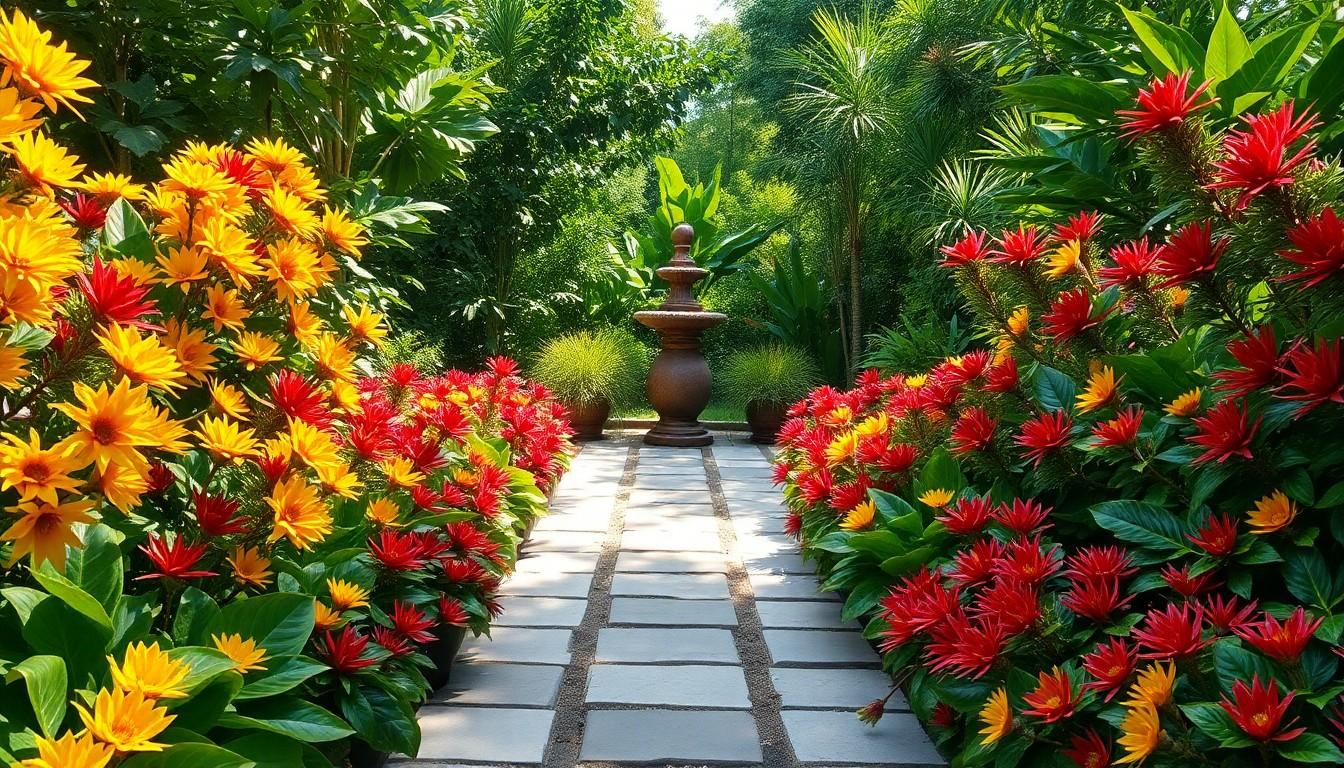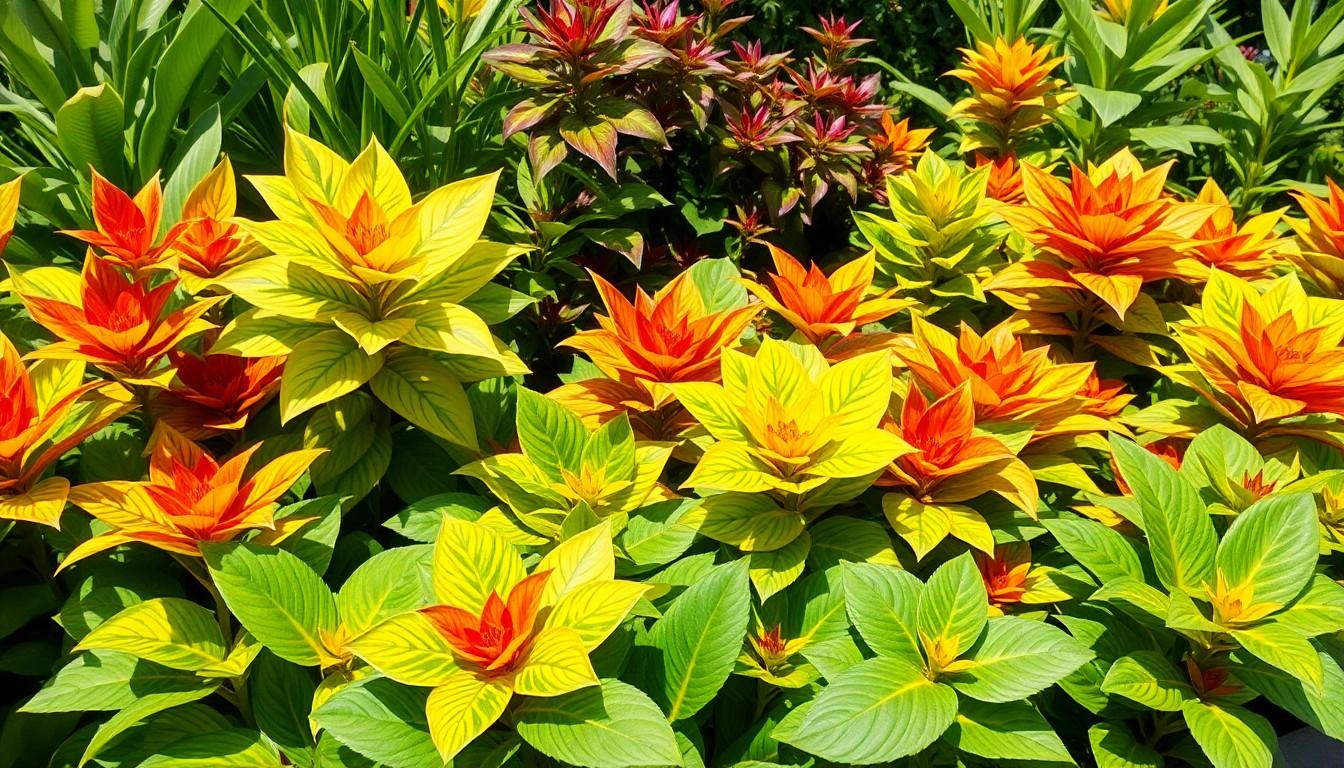Imagine stepping into a vibrant paradise where colors dance and textures play hide and seek. That’s the magic of a croton garden. With their bold hues and striking leaves, crotons can transform any dull outdoor space into a lively retreat. Not only do they add a splash of personality, but they also make your garden the envy of the neighborhood—who wouldn’t want to be known as the “croton connoisseur”?
Landscaping Croton Garden Design
Croton plants stand out for their vibrant foliage and striking appearances. These tropical plants thrive in warm climates, making them ideal for enhancing landscapes.
Characteristics Of Croton Plants
Croton plants feature large, glossy leaves in various colors. Variegated patterns showcase combinations of green, yellow, red, and orange. Different leaf shapes, such as oval or lanceolate, add to their visual diversity. These plants generally grow between 3 to 10 feet in height, depending on the variety and growing conditions. Sunlight exposure influences both growth and coloration; bright, indirect light enhances their vibrancy. Disease resistance is common, yet they can attract pests like aphids if not properly maintained.
Popular Varieties For Landscaping
Several croton varieties excel in landscaping designs. ‘Petra’ boasts bold, multicolored leaves with a mix of red, orange, and yellow hues. ‘Mammy’ features a compact nature and deep green leaves with striking yellow edges. ‘Goldfinger’ offers narrow leaves and bright yellow coloration, ideal for a cheerful atmosphere. ‘Florida Fanfare’ has a unique arrangement and brightly colored foliage. ‘Croton Variegatum’ presents diverse leaf types and colors, suitable for various design themes. Utilizing a mix of these varieties creates visual interest while promoting harmonious outdoor spaces.
Benefits Of Croton In Garden Design
Crotons offer unique advantages in garden design, enhancing both aesthetics and practicality. These benefits make crotons a popular choice for various landscaping projects.
Aesthetic Appeal
Vibrant colors define crotons, transforming gardens into picturesque landscapes. With foliage ranging from deep greens to bright yellows and fiery reds, these plants create striking visual contrasts. Utilizing different varieties, like ‘Petra’ or ‘Mammy,’ adds layers of interest. Variegated patterns further enhance their allure, capturing sunlight for maximum impact. Placing crotons strategically can highlight pathways or focal points, drawing attention to garden features. Seasonal changes in light can alter their appearance, ensuring the garden looks dynamic year-round.
Low Maintenance Requirements
Crotons require minimal upkeep, making them ideal for busy gardeners. These drought-tolerant plants thrive in warm climates, needing only moderate watering. Pest resistance contributes to their low maintenance, with careful observation often sufficing to prevent infestations. Pruning remains minimal, ensuring that gardeners spend less time on upkeep. Fertilization needs remain basic, with a general-purpose fertilizer sufficient for optimal growth. Good drainage in soil promotes healthy root systems, contributing to longevity and resilience in various landscaping settings.
Designing A Croton Garden
Designing a croton garden involves careful planning and consideration of various factors. Proper placement and environment significantly enhance the visual appeal of crotons.
Choosing The Right Location
Selecting the right location is crucial for croton health. Crotons thrive in full sun to partial shade, ideally receiving five to six hours of direct sunlight daily. A space that offers protection from harsh winds will help maintain the plants’ structure. Proximity to patios or walkways allows for easy access and enjoyment. Consider the garden’s overall layout to create visual interest, placing taller varieties toward the back and shorter plants in front. This arrangement ensures a layered look, enhancing depth and beauty in the garden.
Soil And Watering Needs
Soil quality influences croton growth significantly. Well-draining soil rich in organic matter promotes optimal development. A pH range of 6.0 to 6.5 is ideal for crotons. Watering practices must align with their needs, avoiding soggy conditions that could lead to root rot. During dry spells, deep watering encourages strong root systems, while more frequent watering is needed in hotter summer months. Mulching helps retain soil moisture and suppress weeds, creating a more favorable environment for crotons to flourish.
Combining Crotons With Other Plants
Crotons mix well with various plants, enhancing garden vibrancy and diversity. The right companion plants can elevate the aesthetic appeal of croton gardens.
Companion Plants For A Vibrant Look
Consider using colorful flowering plants such as hibiscus, marigolds, and bougainvillea alongside crotons. These blooms provide a striking contrast to croton foliage, enriching the garden’s visual palette. Ornamental grasses like fountain grass or blue fescue can add movement and softness, complementing the boldness of crotons. Additionally, palm trees, such as pygmy date palms or areca palms, create a tropical feel while adding height variation. Select plants that share similar sunlight and moisture requirements to maintain a cohesive garden appearance. Diverse plant selections enhance the overall impact of the croton ensemble.
Creating Texture And Color Contrast
Incorporating plants with different leaf shapes adds texture to croton gardens. For instance, pairing crotons with plants like caladiums contributes to varied leaf structures, enhancing visual interest. Additionally, using darker foliage plants, such as black elephant ears or dark-leaved cannas, creates contrast with bright croton colors. Low-growing ground covers like sedum or sweet potato vine soften edges and fill spaces. This variety of textures and colors ensures the garden presents a dynamic look throughout the seasons. Thoughtful combinations yield a striking landscape design, showcasing the full potential of croton displays.
Maintenance Tips For Croton Gardens
Maintaining a croton garden ensures vibrant and healthy plants all year round. Regular attention to specific care practices optimizes growth and appearance.
Pruning And Fertilization
Pruning crotons improves air circulation and encourages bushier growth. Remove dead or damaged leaves throughout the growing season. Apply a balanced fertilizer every 4 to 6 weeks during active growth, especially in spring and summer. Aim for a fertilizer with equal parts nitrogen, phosphorus, and potassium for optimal results. Observing the plants’ response helps determine if adjustments are necessary.
Pest Management Strategies
Managing pests effectively protects croton health. Inspect plants regularly for insects like aphids or spider mites. If found, habitats of beneficial insects can help maintain balance naturally. Use insecticidal soap as a targeted treatment if infestations appear. Following the manufacturer’s instructions ensures safety and effectiveness. Regularly cleaning leaves with water removes dust and deters pests, promoting a thriving environment for crotons.
Creating a croton garden is a rewarding endeavor that brings vibrant color and texture to any outdoor space. With their striking foliage and low maintenance needs, crotons offer an excellent way to enhance garden aesthetics while minimizing effort.
By thoughtfully selecting varieties and companion plants, gardeners can achieve a visually stunning landscape that showcases the unique beauty of crotons. Regular care and attention to their specific needs ensure these plants thrive, providing year-round enjoyment.
Embracing the art of croton garden design not only beautifies the surroundings but also positions the gardener as a true enthusiast of this captivating plant.


